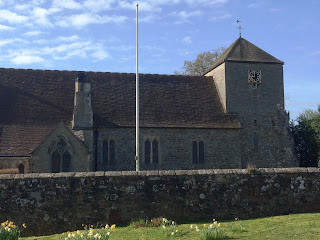Off to show Jennifer Slaugham, so many Still family came from there and it is a beautiful little Village, I had to show her. St Marys church was busy with Easter Sunday Meeting. And we were there early to walk around and check out the village. The census records show the still lived at the green. As the house at the green have all had the names changed since then, it has made to hard locate the exact house.
Talking with a Local they believed it was this one., but she wasn't sure, she just remembers stories of the large family living there.
I also found a bronze cat on one of the roofs. Great idea.
then onto Chetwell – Churchills Home
This Home was a home, Large estate with pond
Walled Garden that was well planted and displayed
A studio behind to paint and relax.
gardens views
And more garden views
Parkland to run the dogs on.
Views of Sussex.
And A house that was large.
Sorry not allowed to take pictures inside due to Copyright issues.
A studio behind to paint and relax.
gardens views
And more garden views
Parkland to run the dogs on.
Views of Sussex.
And A house that was large.
Sorry not allowed to take pictures inside due to Copyright issues.
– This is beautiful place, it is a wonder he ever wanted to leave it. But he did, to save
England and the world.
This place has all I ever wanted, A Large Walled Garden full of fruit trees, vegetables and cutting flowers, an ornamental garden with water gardens, a studio to paint that has a large fireplace to relax in winter, Additional land to raise Horses, pig and lambs, and then to top it off, a small forest to gather firewood from. Not to mention a great large house, also rich enough to employment a house keeper and 2 gardeners. Oh to be rich and powerful.
After that we then cutting across to Knole Park and the huge Home their.
This Magnificent home, castle and the estate is open to the public although the back is still privately owned and the gardens are closed. The grounds are now a deer park. although done were seen due to a large number of dogs running around.
We got to go up the tower
And see the great view of the castle, and see the detail int he roof.
This is castle that as evolded over time and what a long time.
This courtyard is the 1700's while the fornt was 1600's
It was good to explore and again no photo's allowed inside.
Although I seek a few in the Orangery.
The oven was cast iron and was made in the 1800's.
It could only be for a place like this.
It was lunchtime by now and we grabbed food in the car park and made for the next place on the list.





















